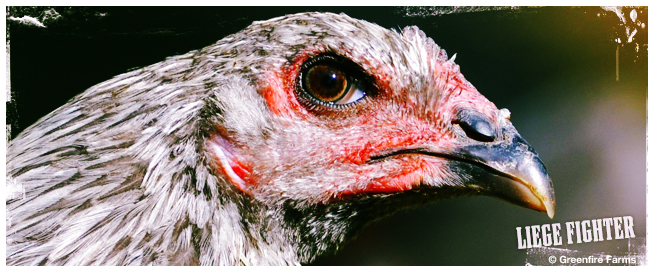Although this giant, muscular Belgian game fowl has a fierce appearance, Liege Fighters are generally friendly toward people and can be an excellent choice for the dedicated hobbyist willing to explore the extremes of the poultry kingdom.
| Item | 1+ | Quantity |
|---|---|---|
| Liege Fighter Day-Old Chick Unsexed | 59.00 | |
| Liege Fighter Eggs | 14.00 | Sold Out |
If you’re looking for a jaw-dropping addition to your chicken coop, you need to look no further than the Liege Fighter. But pity the hawk that tries to threaten a hen when a Liege rooster is on patrol.
Breed History
In Western Europe, for centuries bloodlines of game fowl were carefully selected to survive and dominate in the unforgiving world of the cockpit. Belgians bred their farmyard birds to produce a meaty and powerful chicken breed -- originally called a Lombard’s rooster and later a Bruges Game-- that could vanquish an opponent or fill a roasting pan equally well. In the mid- to late 1800s in eastern Belgium the Bruges Game was crossed with large Asiatic breeds (probably Malays) to produce the Liege Fighter or Luikse Vechter. The Liege Fighter is one of three remaining breeds of Belgian game fowl; the others are the Bruges and the Tirlemont. The Liege Fighter was bred to fight with natural spurs (as opposed to the sharpened metal gaffes commonly seen today) and to be so large and powerful that it could easily overwhelm any other fighting breed.
Appearance and Behavior
The Liege Fighter exhibits several striking characteristics. One is their size. Adult roosters can exceed 30” in height and weigh up to 12 lb. They can grow to be twice as large as American game fowl. Their weight consists primarily of muscle, and they are an intimidating breed in appearance. Their feet are truly huge; the largest we have seen in any chicken breed and as large as a turkey's feet. Second is their plumage. Their feathers lay close to their body as they don't have much under-fluff (the downy feathers). In a way, this helps accentuate their height. Our flock consists of blue, black, and splash-colored birds. This means our flock produces those three colors as well. Some of the roosters that we've seen grow out, grew to be blue-based with gold throughout their hackles and wings whereas other blue-based roosters had blonde throughout their hackles and wings. We've also seen black-based roosters with gold and some with the blonde too. We think all are stunning. The third striking characteristic is their face. They have an incredibly fierce gaze which is shielded by the overhang of a prominent brow. This breed doesn't tend to grow wattles and if they do have them, they are very small. The comb shape tends to resemble a pea comb with three ridges. Despite their very intimidating appearance, these birds are friendly with their human handlers.
The hens are smaller than the roosters at about 8 pounds and lay cream-colored eggs in reasonably large numbers. On average you'll get about 150 eggs per year from them. During their first 2 years, they lay very consistently and a hen may lay around 200 eggs. After 2 years, their egg production will decrease slightly. Both the roosters and the hens are extremely curious birds. We say they are nosey. They always have to be right near us if we are in their pen, to the point it's hard to walk without bumping into one of the birds. The hens aren't typical broody so if you plan to hatch chicks we recommend you invest in a good quality incubator.
Since this breed is so large and heavy, you should ensure that the perch height for the birds is no higher than 36" from the ground. This will reduce injury to the birds when they jump down from the perches.
Breeding
The Liege Fighter do well at a rooster-to-hen ratio of about 1:10. The birds are very active in terms of mating and foraging. So we typically have viability above 75% and it doesn't tend to fluctuate a lot throughout the year.
Check out these pages for information about the breed and notes from a breeder located in Belgium:
https://luiksevechter.weebly.com/raskenmerken.html
http://www.aviculture-europe.nl/nummers/12E06A12.pdf
Integrations
Interestingly enough, the Liege Fighter roosters don't typically grow into their confidence until they are at least 6 to 7 months old. This means integrating a Liege cockerel or rooster into an existing flock can be done in a few different ways. You can try integrating the cockerel into a mixed flock that already has a rooster, that isn't a gamefowl breed, before the Liege is 8 months old. The established rooster will of course put the Liege in his place and typically the Liege will not challenge much. As long as the established rooster doesn't continue to fight the Liege, then the integration is successful and as the Liege ages, he and the other rooster will work out the pecking order as they age. Typically this is the easiest way to integrate. This is also the method we recommend if you have an established bantam rooster and you want to add the Liege fighter to the group. We've housed bantam roosters with Liege Fighter roosters with no issue by using this method or the following method.
If you have cockerels that are about the same age they can be housed in a bachelor pen. This is what we tend to do as we grow out cockerels from various breeds. We typically consolidate about 30 cockerels into a large pen when they are about the same age, about 3 months old. The hierarchy is established pretty quickly and is typically mild. They tend to fight much less since they aren't fully mature.
If you have a Liege Fighter flock and want to add another rooster, you should wait until the new rooster is at least 8 to 9 months old before integrating. This way the interaction is more evenly matched. However, this method doesn't always succeed. The key to using this method is that you have to make sure you have enough hens for both roosters and that the pen is roomy. Using the ratio of 1:10, if you want to have 2 roosters in your flock then you should have 20 hens. If you don't have enough hens or enough space, the integration will fail. If it does fail, you should remove the new rooster and make changes to the flock, and they try again after the new rooster has had time to rest and recover. Sometimes this just means waiting until the rooster is larger and more confident.
There isn't one integration method that will work 100% of the time. Always monitor the birds closely when you integrate a new one into a flock, no matter the breed.
Hatching Eggs
We hatch at 99.5F and 55% humidity. Normally we see about a 75% hatch rate from the eggs that are placed into the hatcher. The majority of the chicks will hatch on day 21 and we normally see a male-to-female ratio of 50:50. Our flock produces chicks in black, blue, and splash with the majority being blue right as of March 2024.
Notes
Greenfire Farms is the original importer of this breed into the United States. Since our flock produces blue, black, and splash offspring we will do our best to pack your order with a variety of colored chicks.
Breed History
In Western Europe, for centuries bloodlines of game fowl were carefully selected to survive and dominate in the unforgiving world of the cockpit. Belgians bred their farmyard birds to produce a meaty and powerful chicken breed -- originally called a Lombard’s rooster and later a Bruges Game-- that could vanquish an opponent or fill a roasting pan equally well. In the mid- to late 1800s in eastern Belgium the Bruges Game was crossed with large Asiatic breeds (probably Malays) to produce the Liege Fighter or Luikse Vechter. The Liege Fighter is one of three remaining breeds of Belgian game fowl; the others are the Bruges and the Tirlemont. The Liege Fighter was bred to fight with natural spurs (as opposed to the sharpened metal gaffes commonly seen today) and to be so large and powerful that it could easily overwhelm any other fighting breed.
Appearance and Behavior
The Liege Fighter exhibits several striking characteristics. One is their size. Adult roosters can exceed 30” in height and weigh up to 12 lb. They can grow to be twice as large as American game fowl. Their weight consists primarily of muscle, and they are an intimidating breed in appearance. Their feet are truly huge; the largest we have seen in any chicken breed and as large as a turkey's feet. Second is their plumage. Their feathers lay close to their body as they don't have much under-fluff (the downy feathers). In a way, this helps accentuate their height. Our flock consists of blue, black, and splash-colored birds. This means our flock produces those three colors as well. Some of the roosters that we've seen grow out, grew to be blue-based with gold throughout their hackles and wings whereas other blue-based roosters had blonde throughout their hackles and wings. We've also seen black-based roosters with gold and some with the blonde too. We think all are stunning. The third striking characteristic is their face. They have an incredibly fierce gaze which is shielded by the overhang of a prominent brow. This breed doesn't tend to grow wattles and if they do have them, they are very small. The comb shape tends to resemble a pea comb with three ridges. Despite their very intimidating appearance, these birds are friendly with their human handlers.
The hens are smaller than the roosters at about 8 pounds and lay cream-colored eggs in reasonably large numbers. On average you'll get about 150 eggs per year from them. During their first 2 years, they lay very consistently and a hen may lay around 200 eggs. After 2 years, their egg production will decrease slightly. Both the roosters and the hens are extremely curious birds. We say they are nosey. They always have to be right near us if we are in their pen, to the point it's hard to walk without bumping into one of the birds. The hens aren't typical broody so if you plan to hatch chicks we recommend you invest in a good quality incubator.
Since this breed is so large and heavy, you should ensure that the perch height for the birds is no higher than 36" from the ground. This will reduce injury to the birds when they jump down from the perches.
Breeding
The Liege Fighter do well at a rooster-to-hen ratio of about 1:10. The birds are very active in terms of mating and foraging. So we typically have viability above 75% and it doesn't tend to fluctuate a lot throughout the year.
Check out these pages for information about the breed and notes from a breeder located in Belgium:
https://luiksevechter.weebly.com/raskenmerken.html
http://www.aviculture-europe.nl/nummers/12E06A12.pdf
Integrations
Interestingly enough, the Liege Fighter roosters don't typically grow into their confidence until they are at least 6 to 7 months old. This means integrating a Liege cockerel or rooster into an existing flock can be done in a few different ways. You can try integrating the cockerel into a mixed flock that already has a rooster, that isn't a gamefowl breed, before the Liege is 8 months old. The established rooster will of course put the Liege in his place and typically the Liege will not challenge much. As long as the established rooster doesn't continue to fight the Liege, then the integration is successful and as the Liege ages, he and the other rooster will work out the pecking order as they age. Typically this is the easiest way to integrate. This is also the method we recommend if you have an established bantam rooster and you want to add the Liege fighter to the group. We've housed bantam roosters with Liege Fighter roosters with no issue by using this method or the following method.
If you have cockerels that are about the same age they can be housed in a bachelor pen. This is what we tend to do as we grow out cockerels from various breeds. We typically consolidate about 30 cockerels into a large pen when they are about the same age, about 3 months old. The hierarchy is established pretty quickly and is typically mild. They tend to fight much less since they aren't fully mature.
If you have a Liege Fighter flock and want to add another rooster, you should wait until the new rooster is at least 8 to 9 months old before integrating. This way the interaction is more evenly matched. However, this method doesn't always succeed. The key to using this method is that you have to make sure you have enough hens for both roosters and that the pen is roomy. Using the ratio of 1:10, if you want to have 2 roosters in your flock then you should have 20 hens. If you don't have enough hens or enough space, the integration will fail. If it does fail, you should remove the new rooster and make changes to the flock, and they try again after the new rooster has had time to rest and recover. Sometimes this just means waiting until the rooster is larger and more confident.
There isn't one integration method that will work 100% of the time. Always monitor the birds closely when you integrate a new one into a flock, no matter the breed.
Hatching Eggs
We hatch at 99.5F and 55% humidity. Normally we see about a 75% hatch rate from the eggs that are placed into the hatcher. The majority of the chicks will hatch on day 21 and we normally see a male-to-female ratio of 50:50. Our flock produces chicks in black, blue, and splash with the majority being blue right as of March 2024.
Notes
Greenfire Farms is the original importer of this breed into the United States. Since our flock produces blue, black, and splash offspring we will do our best to pack your order with a variety of colored chicks.
| Egg Color | tinted |
| Egg Size | Large |
| Average number of eggs per year | 150 |
| Gamefowl | yes |
| Country of Origin | Belgium |
| Also called | Luikse Vechter |
| Cold tolerant | yes |
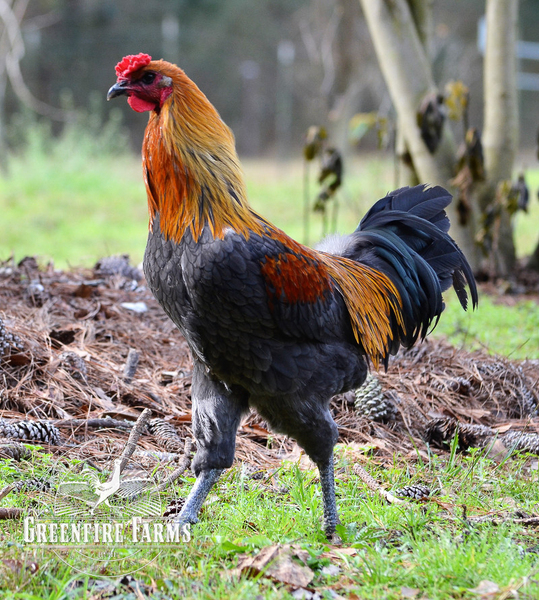

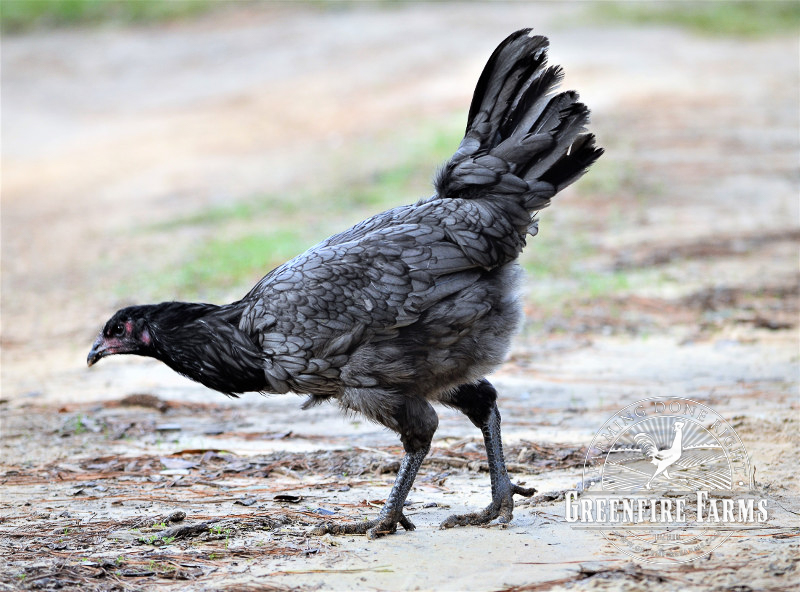
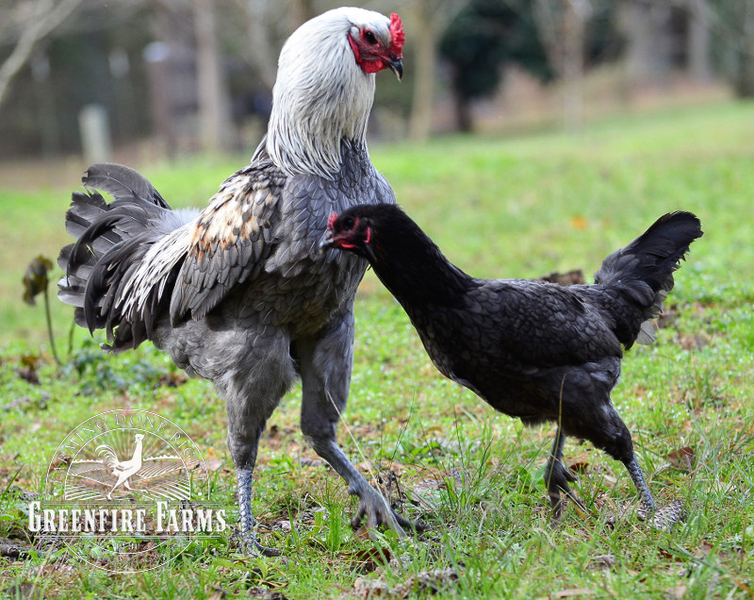

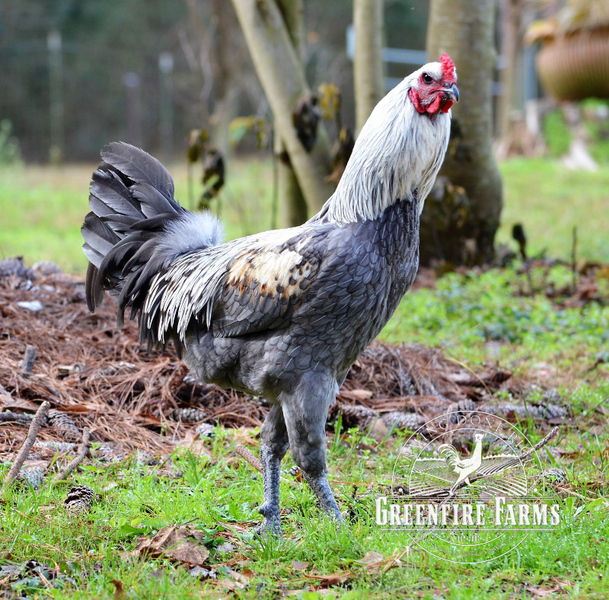
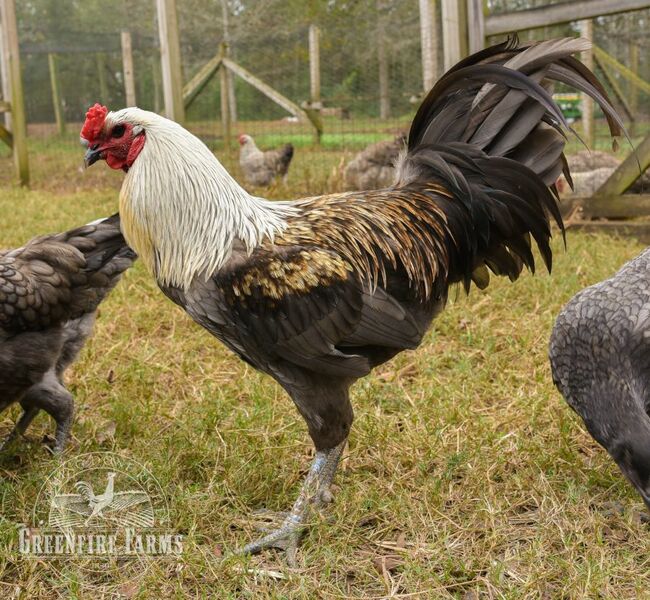

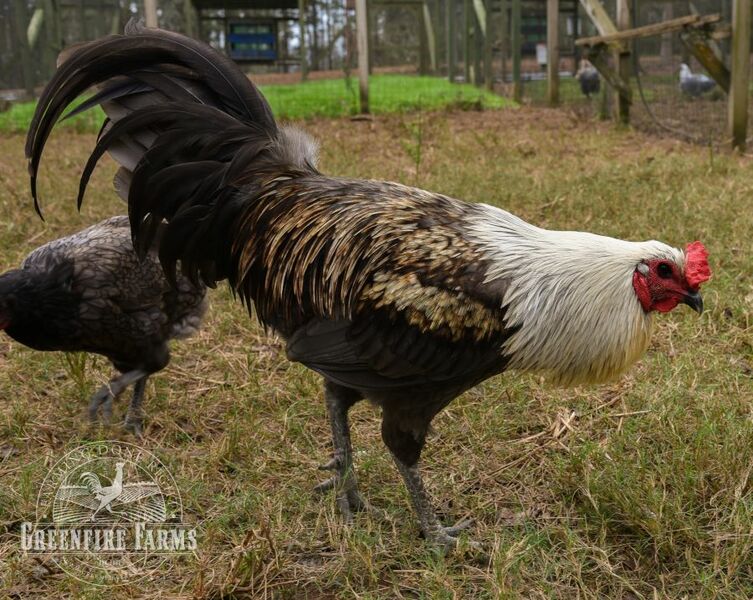

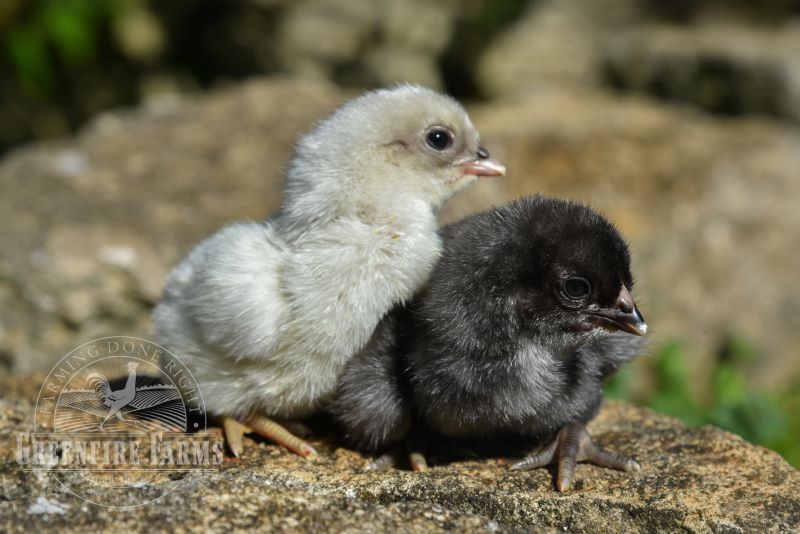
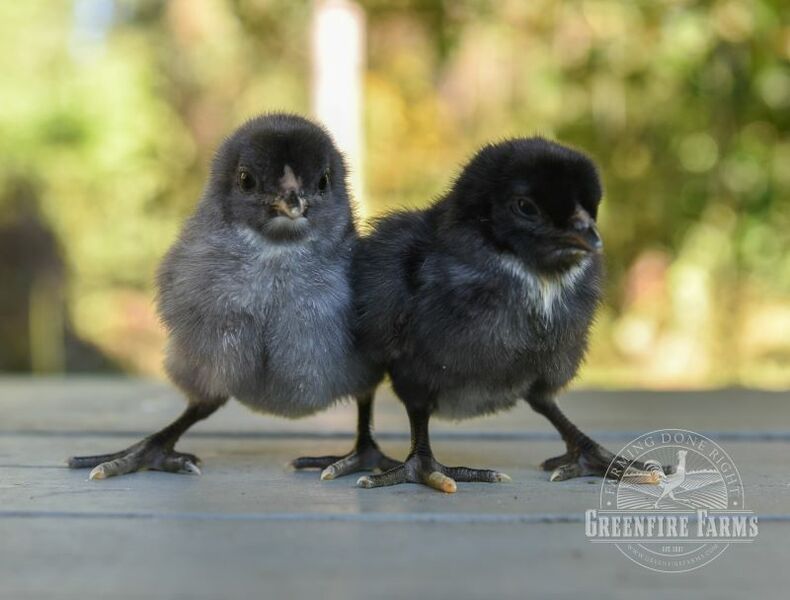


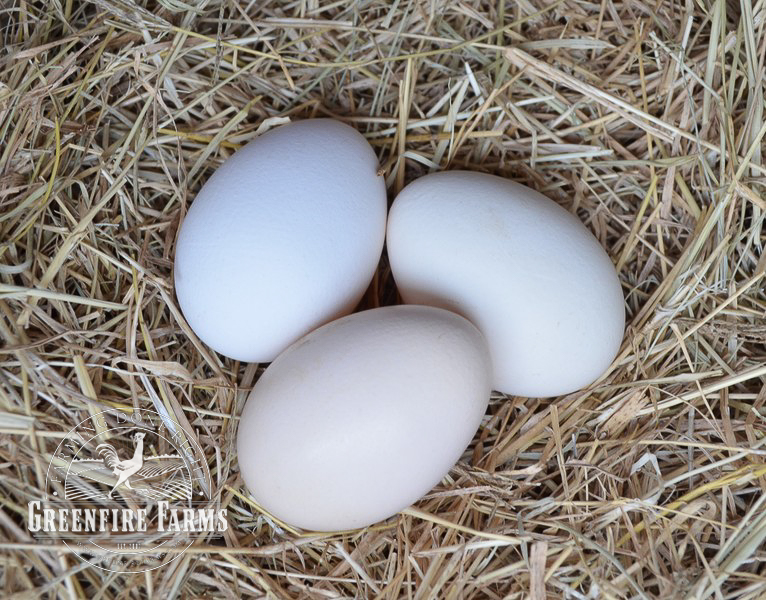

 Cart:
Cart: 

